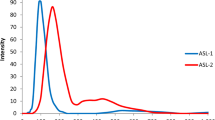Abstract
The role of coalescing agents in the film formation process is studied by means of the turbidity technique, i.e., analysis of light transmission and interference. The basic influence of coalescing agents is (a) lowering the minimum film formation temperature of the latex dispersion, (b) increasing the drying time and (c) improvement of coalescence. Application of coalescing agents also causes a change in polymer particle size as coalescing agents made of TEXANOL (2,2,4 trimethyl-1,3 pentanediol monoisobutyrate) and ethylene glycol monobutyl ether (EB) were used. Turbidity is shown to be a better method to optimize the amount of coalescing agent in a film formation process than the usual brass bar.







Similar content being viewed by others
References
Cruz EP (1991) Euro Coat 4:204
Waldie JM, Bonney DD (1983) Surface coatings raw materials and their usage, vol 1. Chapman and Hall, London
De Fusco AJ (1989) Modern paint and coating 56
Wang Y, Winnik MA (1990) Macromolecules 23:4731
Guthrie DH (1988) In: Water-borne and higher-solids coating symposium, New Orleans, p 208
Toussaint A, De Wilde M (1997) Progress in organic coatings 30:173
Fox TG, Bull AM (1956) Phys Sci 1:123
Toussaint A, De Wilde M, Molenar F, Mulvihill J (1997) Progress in organic coatings 30:179
Zwinselman J (1990) Euro Coat 10:514
Pekcan O, Winnik MA, Croucher MD (1990) Macromolecules 23:2673
Zhao CL, Wang Y, Hrnska Z, Winnik MA (1990) Macromolecules 23:4082
Wang Y, Zhao CL, Winnik MA (1991) J Chem Phys 95:2143
Winnik MA, Wang Y, Haley F (1992) J Coat Technol 64:51
Juhue D, Wang Y, Winnik MA (1993) Makromol Chem Rapid Commun 14:345
Juhue D, Lang J (1994) Macromolecules 27:695
Prager S, Adolf D, Tirrell M (1986) J Chem Phys 84:5152
Whitlow SJ, Wool RP (1991) Macromolecules 24:5926
Wang Y, Juhue D, Winnik MA, Leung OM, Goh M (1992) Langmuir 8:760
Goh MC, Juhue D, Leung OM, Wang Y, Winnik MA (1993) Langmuir 9:1319
Butt HJ, Kuropka R, Christensen B (1994) Colloid Polym Sci 272:1218
Lin F, Meier DJ (1995) Langmuir 11:2726
Goudy A, Gee ML, Biggs S, Underwood S (1995) Langmuir 11:4454
Patel AA, Feng J, Winnik MA, Vancso GJ, Dittman Mc Bain CB (1996) Polymer 37:5577
Lin F, Meier DJ (1996) Prog Org Coat 29:139
Juhue D, Wang Y, Lang J, Leung OM, Goh MC, Winnik MA (1995) J Polym Sci Part B Polym Phys 33:1123
Te Nijenhuis K, Zohrehvand S (2005) J Colloid Int Sci Part 2 284:129
Chainey M, Wilkinson MC (1985) J Polym Sci Polym Chem Ed 23:2947
Isaac FK (1966) J Macromol Chem 1:163
Vanderhoff JW, Bradford EB, Carrington WK (1973) J Polym Sci Polym Symp 41:155
Greene BW, Nelson AR, Keskey WH (1980) J Phys Chem 84:1615
Ming Y, Takamura K, Davis HT, Scriven E (1995) Tappi J 78:151
Comyn J (1985) Polymer permeability. Elsevier, London
Barrer RM (1957) J Phys Chem 61:178
Mulvihill J, Toussaint A, De Wilde M (1997) Prog Org Coat 30:127
Zohrehvand S (2001) PhD Thesis, Delft University of Technology
Winnik MA (1997) In: Lovell PA, El-Aasser MS (eds) Emulsion polymerization and emulsion polymers, ch 1. Wiley, Chichester
Van Tent A (1992) PhD Thesis, Delft University of Technology
Van Tent A, Te Nijenhuis K (1991) In: AV Patsis (ed) Proceedings of XVIIth international conference in organic coatings science and technology, Luzern, p 317
Van Tent A, Te Nijenhuis K (1992) Prog Org Coat 120:459
Te Nijenhuis K (2002) In: Hubbard A (ed) Encyclopedia of surface and colloid science. Marcel Dekker, New York, p 5396
Van Tent A, Te Nijenhuis K (2000) J Colloid Int Sci 232:350
Zohrehvand S, Cai R, Reuvers AJ, Te Nijenhuis K, Posthuma de Boer A (2005) J Colloid Int Sci Part 1 284:120
Van Tent A, Te Nijenhuis K (1992) J Colloid Int Sci 150:97
Zohrehvand S, Te Nijenhuis K (2005) J Colloid Int Sci Part 5 288:75
Eckersley ST, Rudin A (1990) J Coat Technol 62:89
Jenson DP, Morgan LW (1991) J Appl Polym Sci 42:2845
Acknowledgements
The authors gratefully acknowledge the financial support of the Dutch Innovative Research Programme on Paints (IOP-Verf). The authors are also much indebted to Dr. P. Vink for his suggestion to explain the delayed drying behaviour of latices containing only 1% of EB.
Author information
Authors and Affiliations
Corresponding author
Rights and permissions
About this article
Cite this article
Zohrehvand, S., Nijenhuis, K.t. Film formation from monodisperse acrylic latices, part 4: the role of coalescing agents in the film formation process. Colloid Polym Sci 283, 1305–1312 (2005). https://doi.org/10.1007/s00396-005-1333-2
Received:
Accepted:
Published:
Issue Date:
DOI: https://doi.org/10.1007/s00396-005-1333-2




